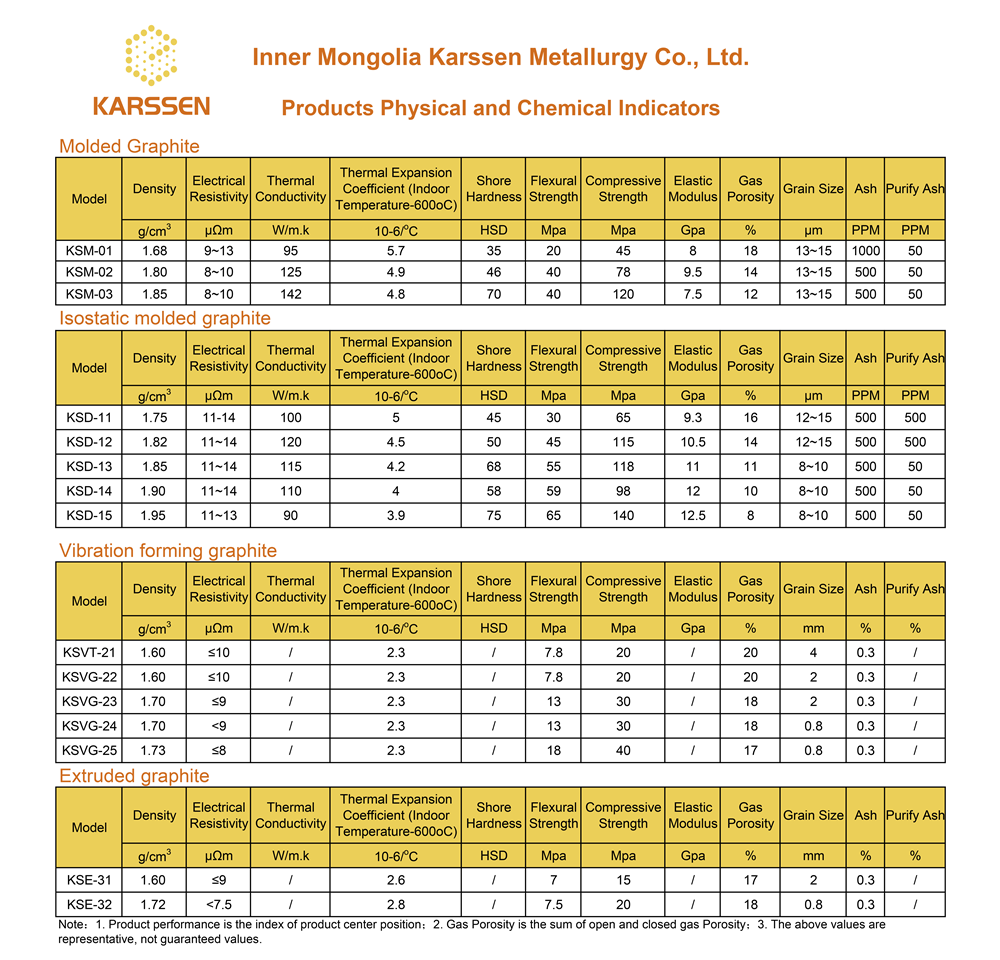Email: info@karssenmetal.com Tel: +86 18147353336
isostatic graphite block

Properties of isostatically pressed graphite
1. It has good heat resistance. In an inert atmosphere, its mechanical strength increases with the increase of temperature, reaching the maximum value at about 2500°C;
2. Compared with ordinary graphite, it has good uniformity and fine and dense structure;
3. Low thermal expansion coefficient and good thermal shock resistance;
4. Isotropic, consistent performance in all directions;
5. It has strong chemical corrosion resistance and can withstand the penetration and erosion of molten metal and glass; it has good electrical and thermal conductivity; it has excellent mechanical processing performance and can be processed into almost any shape of items.
Therefore, isostatic graphite is widely used in the production of CZ-type single crystal Czochralski furnace thermal field graphite components (crucible, heater, guide tube, insulation cover, etc.), polysilicon smelting furnaces, heaters, crucibles and other components for compound semiconductor manufacturing. , rocket ignition pole, excitation pole, nozzle and rudder plate, nuclear reactor core structure, electrodes for electrical discharge machining, graphite crystallizer for continuous casting metal, etc.
The main molding methods of isostatically pressed graphite
The current molding methods include: extrusion molding, compression molding, vibration molding and isostatic pressing. Most of the common carbon/graphite materials on the market are formed by hot extrusion and molding (cold or hot). Isostatic pressing is a method with leading advantages in molding performance. Vibration molding is generally used to produce medium-coarse structure graphite, with a particle size between 0.5-2mm. Generally, double-baked graphitized products are mainly used, with a density between 1.55-1.75kg/m³, with coarse particles and a rough surface. , cannot be used for precision machining. Mainly used in chemical industry and metal smelting.
Characteristics of isostatically pressed graphite materials
Isostatically pressed graphite material has good isotropy, and its characteristics are independent of shape, size, and sampling direction; the material has a dense structure, high mechanical strength, high surface hardness, strong oxidation resistance, and high temperature resistance; the material has good thermal shock resistance and is It is not easy to crack under the working conditions of rapid cooling and rapid heating.
1. Isotropic
Different molding methods have different performances in different directions. Mainly manifested in: resistivity, thermal conductivity, mechanical properties, thermal expansion coefficient, etc. The general measurement method is: take samples from the product in the direction perpendicular to the pressure surface and horizontal to the pressure surface, measure the performance respectively, and then divide the data on the smallest side by the data on the largest side to get the isotropic peer ratio.
2. Large size
The market's requirements for product size specifications are increasing. Taking Czochralski monocrystalline silicon as an example, monocrystalline silicon products have grown from 6 or 8 inches to the current 12 inches. The size of graphite materials used in thermal fields is also increasing. Other related industries are similar. Graphite for EDM, continuous casting graphite, and graphite for nuclear reactors also require large-scale products. This is difficult to achieve using molding and extrusion methods.
The main problem that occurs in the production of large-sized products is roasting cracking, the larger the size. The chance of cracking during baking is also higher.
3. Fine structure
As a structural material, it requires high physical and chemical properties.
On the one hand, the finer the particle size of the basic carbon particles that constitute the carbon/graphite material, the denser the texture and the higher the mechanical strength. On the other hand, the finer the particles of carbon aggregate, the larger the surface area. The binder must be evenly coated on the surface of each particle, and the greater the amount of binder used in the formula. This increases the scrap rate of sintering, and it is difficult to increase the degree of graphitization.
In the smelting process of non-ferrous metals su
Isostatic graphite blocks are an important graph
Graphite rotor belongs to graphite material, whi
Contact: Bateer
Phone: +86 18147353336
Tel: +86 18147353336
Email: info@karssenmetal.com
Add: Room D204-2203, Innovation Building, Baotou Light Industry Vocational Technical College, 19 Jianhua Road, Qingshan District, Baotou City, Inner Mongolia, China.